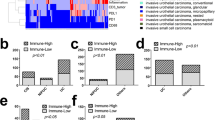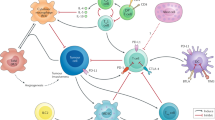Summary
Treatment of superficial bladder cancer is shifting toward a more conservative attitude with a widespread use of intravesical immunotherapy. There is a need for markers which can reliably identified patients at risk for progression for whom radical cystectomy remains the most effective treatment. Progress in immunopathology and definition of new tumor markers by hybridoma technology allow analysis of multiple prognostic indicators which may be clinically relevant.
Similar content being viewed by others
References
Slack NH, Prout GR Jr (1980) Heterogeneity of invasive bladder carcinoma and different responses to treatment. In: Bonney WW, Prout GR Jr (eds) AUA monographs, bladder cancer. Williams and Wilkins, Baltimore, p 213
Kaye KW, Lange PH (1982) Mode of presentation of invasive bladder cancer: reassessment of the problem. J Urol 128:31
DeCenzo JM, Howard P, Irish CE (1975) Antigen deletion and prognosis of patients with stage A transitional cell bladder carcinoma. J Urol 114:874
Tribukait B (1986) Diagnostic and prognostic significance of modal DNA-values and proportion of S-phase cells in human carcinoma of the bladder. In: Morphometry, stereology and image analysis in cancer cytology and histopathology. Elsevier (in press)
Devonec M, Darzynkiewicz Z, Kostyrka-Claps ML, Collste L, Whitmore WF, Melamed MR (1982) Flow cytometry of low stage bladder tumors: correlation with cytologic and cystoscopic diagnosis. Cancer 49:109
Jakse G, Rauschmeier H, Rosmanith P, Hofstader (1983) Determination of carcinoembryonic antigen in tissue serum and urine in patients with transitional cell carcinoma of the urinary bladder. Urol Int 38:121
Tanaka T, Salmon DJ, Battifora H, Cline MJ (1986) Expression of p21 ras oncoproteins in human cancers. Cancer Res 46:1465
Coons AH, Kaplan MH (1950) Localization of antigens in tissue culture cells. II. Improvement in a method for the detection of antigen by means of fluorescent antibody. J Exp Med 93:1
Polak J, Van Noorden S (1983) Immunocytochemistry, practical application in pathology and biology. Wright, PSG
Bean MA, Bloom BR, Herberman RB, Old LJ, Oettgen HF, Klein G, Terry WD (1975) Cell mediated cytotoxicity for bladder carcinoma evaluation of a workshop. Cancer Res 35:2902
Hashimoto Y, Kitagawa HS (1979) Antigens characteristics of nitrosamine-induced urinary bladder cancer in rats. GANN 70:305
Masuko T, Yagita H, Hashimoto Y (1984) Monoclonal antibodies against cell surface antigens present of human urinary bladder cancer cells. JNCI 72:523
Fradet Y, Cordon-Cardo C, Whitmore WF Jr, Melamed MR, Old LJ (1986) Cell surface antigens of human bladder tumors: definition of tumor subsets by monoclonal antibodies and correlation with growth characteristics. Cancer Res 46:5183
Baricordi OR, Sensi A, De Vinci C, Melchiorri L, Fabris G, Marchetti E, Corrado F, Mattiuz PL, Pizza G (1985) A monoclonal antibody to human transitional-cell carcinoma of the bladder cross-reacting with a differentiation antigen of neutrophilic lineage. Int J Cancer 35:781
Chopin DK, de Kernion JB, Rosenthal DL, Fahey JL (1985) Monoclonal antibodies against transitional cell carcinoma for detection of malignant urothelial cells in bladder washings. J Urol 134:260
Rearden A, Naschtsheim DA, Frisman DM, Chiu P, Elmajian DA, Baird SM (1983) Altered cell surface antigen expression in bladder carcinoma detected by a new hemagglutinating monoclonal antibody. J Immunol 131:3073
Young D, Prout GR Jr, Lin C (1985) Production and characterization of mouse monoclonal antibodies to human bladder tumor associated antigens. Cancer Res 45:4439
Ben Aissa H, Paulie S, Koho H, Biberfeld P, Hansson Y, Lunblad ML, Gustafson H, Jonsdottir I, Perlmann P (1985) Specificities and binding properties of 2 monoclonal antibodies against carcinoma cells of the human urinary bladder. Br J Cancer 52:65
Summerhayes IC, Mclihinney RAJ, Ponder BAJ, Shearer RJ, Pocock RD (1985) Monoclonal antibodies raised against cell membrane components by human bladder tumor tissue recognizing subpopulation in normal urothelium. JNCI 75:1025
Thor A, Horanhand P, Wunderlich D, Caruso A, Muraro R, Schlom J (1984) Monoclonal antibodies define differential RAS gene expression in malignant and benign colonic disease. Nature (Lond) 311:562
Paulie S, Lundblad ML, Hansson Y, Koho H, Ben Aissa H, Perlmann P (1984) Production of antibodies to cellular antigens by EBV-transformed lymphocytes from patients with urinary bladder carcinoma. Scand J Immunol 20:461
Davidsohn I, Kovarik S, Ly N (1969) Isoantigen A, B and H in benign and malignant lesions of the cervix. Arch Pathol 87:306
Coombs RRA, Bedford D, Rouillard LM (1956) A and B blood group antigens on human epidermal cells demonstrated by mixed agglutination. Lancet 1:461
Catalona WJ (1981) Practical utility of specific red cell adherence test in bladder cancer. Urology 18:113
Stephenson TJ, Williams JL, Gelsthorpe K (1985) Monoclonal antibodies to detect A, B and H blood group isoantigens in superficial transitional cell carcinoma of the bladder: a means of predicting invasive recurrence. Br J Urol 57:148
Coon JS, Weinstein RS, Summers JL (1982) Blood group precursor T-antigen expression in human urinary bladder carcinoma. Am J Clin Pathol 77:692
Limas C, Lange P (1985) Lewis antigen in normal and neoplastic urothelium. Am J Clin Pathol 121:176
Nathrath WBJ, Arnholdt H, Wilson PD (1982) Keratin, luminal epithelial antigen and carcinoembryonic antigen in human urinary bladder carcinomas. Pathol Res Pract 175:299
Pocock RD, Ibrahim SK, Sloane JP, Ponder BAJ, Shearer RJ (1983) Potential value of antisera to epithelial membrane antigen in detecting early invasion in transitional cell carcinoma. Br J Urol 55:670
Jautzke G, Altenaehr E (1982) Immunohistochemical demonstration of carcinoembryonic antigen (CEA) and its correlation with grading and staging on tissue sections of urinary bladder carcinomas. Cancer 50:2052
Summers JL, Coon JS, Ward RM, Falor WH, Miller III AW, Weinstein RS (1983) Prognosis in carcinoma of the urinary bladder based upon tissue blood group ABH and Thomsen-Freidenreich antigen status and karyotype of the initial tumor. Cancer Res 43:934
Whitmore KE, Chopin DK, Bubbers JEB, deKernion JB, Fahey JL (1987) Immunohistochemical of prediction of invasive recurrence of transitional cell carcinoma with a panel of tumor marker. J Urol (in press)
Author information
Authors and Affiliations
Rights and permissions
About this article
Cite this article
Chopin, D.K., Whitmore, K.E., Abbou, C.C. et al. Immunopathology of urothelial lesions: immunological markers as predictive for clinical aggressiveness. World J Urol 5, 133–137 (1987). https://doi.org/10.1007/BF00327071
Issue Date:
DOI: https://doi.org/10.1007/BF00327071




